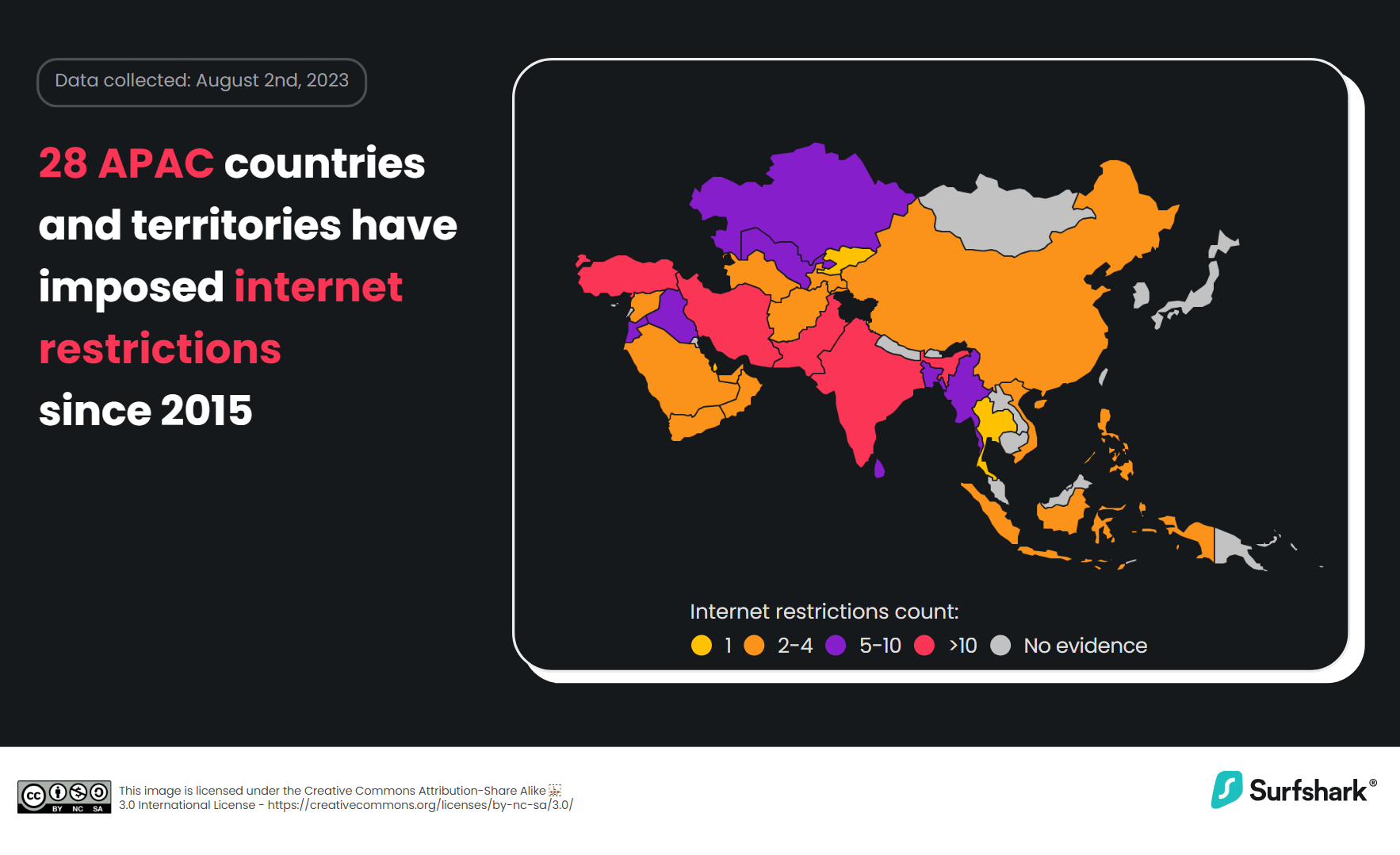A new study is shedding light on the growing number of internet restrictions taking center stage and when we look at stats, it’s the Asia Pacific region that suffered more than others.
The APAC experienced the most outbreaks where a whopping 89% of the population have been used to the behavior that first began arising in 2015. This was either linked to elections, ongoing protests or demonstrations, or just the worse political unrest. Another reason that has been outlined includes the harsh internet laws.
The news comes to us thanks to the most reliable data provided by Surfshark who is making use of a Shutdown Tracker from the web.
Some more major insights regarding the restrictions in the APAC region have been delineated and we’re describing them for you below.
For starters, close to 50% of those nations that fall in the Asia Pacific region were analyzed and it was proven how most were limited by the ongoing restrictions by the internet since the year 2015. That really did affect 89% of the whole region’s population and some of the effects carried on for so long after that too.
You’ll even be amazed to learn how most of the nations continue to have restrictions taking place and some of the implications last for a decade or more. Let’s take China for example. The latter put a ban on social media apps in 2009 and now that we’ve entered 2023, the ban is still in place.
Then when we go back to the year 2015, that time period saw close to 585 restrictions on the web in the same region. A lot of it was linked to protests, most of them having to do with India where political unrest took center stage. Alone, the nation was responsible for 85 of such cases alone.
Then we saw close to 31 restrictions taking place during the phase of the elections and this was the case linked to Bangladesh and its respective election period. Some of the cases had to do with stringent laws of the internet while close to 350 were linked to political unrest situations.
Out of all the cases that continued to be recorded on a daily basis, close to 75 had been targeted on various social media apps. The big names including Meta’s WhatsApp, Instagram, and Facebook were a part of this where they had to be blocked in this part of the world.
While Facebook was barred 36 times, Instagram received close to 26 restrictions. And last but not least, it was WhatsApp that had been barred 24 times.
The data taken for the analysis was through an Internet Shutdown Tracker. They analyzed all the nations which were confirmed as having internet restrictions that have to do with the current scenario or something linked to the past.
The nations that were considered for the study were all from the United Nations’ official list.
Read next: Study Shows, Verifying Facts Appears To Have an Impact On Social Media Recommendation Algorithm
The APAC experienced the most outbreaks where a whopping 89% of the population have been used to the behavior that first began arising in 2015. This was either linked to elections, ongoing protests or demonstrations, or just the worse political unrest. Another reason that has been outlined includes the harsh internet laws.
The news comes to us thanks to the most reliable data provided by Surfshark who is making use of a Shutdown Tracker from the web.
Some more major insights regarding the restrictions in the APAC region have been delineated and we’re describing them for you below.
For starters, close to 50% of those nations that fall in the Asia Pacific region were analyzed and it was proven how most were limited by the ongoing restrictions by the internet since the year 2015. That really did affect 89% of the whole region’s population and some of the effects carried on for so long after that too.
You’ll even be amazed to learn how most of the nations continue to have restrictions taking place and some of the implications last for a decade or more. Let’s take China for example. The latter put a ban on social media apps in 2009 and now that we’ve entered 2023, the ban is still in place.
Then when we go back to the year 2015, that time period saw close to 585 restrictions on the web in the same region. A lot of it was linked to protests, most of them having to do with India where political unrest took center stage. Alone, the nation was responsible for 85 of such cases alone.
Then we saw close to 31 restrictions taking place during the phase of the elections and this was the case linked to Bangladesh and its respective election period. Some of the cases had to do with stringent laws of the internet while close to 350 were linked to political unrest situations.
Out of all the cases that continued to be recorded on a daily basis, close to 75 had been targeted on various social media apps. The big names including Meta’s WhatsApp, Instagram, and Facebook were a part of this where they had to be blocked in this part of the world.
While Facebook was barred 36 times, Instagram received close to 26 restrictions. And last but not least, it was WhatsApp that had been barred 24 times.
The data taken for the analysis was through an Internet Shutdown Tracker. They analyzed all the nations which were confirmed as having internet restrictions that have to do with the current scenario or something linked to the past.
The nations that were considered for the study were all from the United Nations’ official list.
Read next: Study Shows, Verifying Facts Appears To Have an Impact On Social Media Recommendation Algorithm

